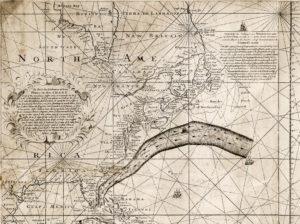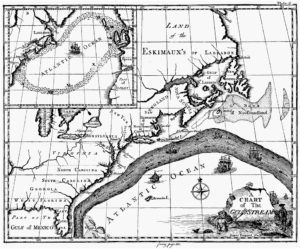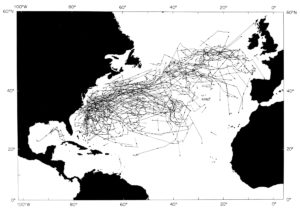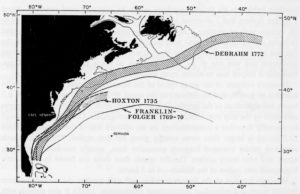Historical Studies
Studies of some historical aspects of ocean circulation such as the discovery of Ben Franklin’s first chart of the Gulf Stream, the history of schematic diagrams of the meridional overturning circulation, drifting derelicts in the Atlantic, and the Columbus landfall controversy.
Publications
Richardson, P. L., 2018. Leonardo da Vinci’s discovery of birds dynamic soaring in wind shear. Royal Society Notes & Records, doi:10.1098/rsnr.2018.0024.
Richardson, P. L. and Adams, N. T., 2018. Nantucket Whalers and the Franklin-Folger chart of the Gulf Stream. Historic Nantucket, Spring 2018, 17-24.
Richardson, P. L., 2017. Da Vinci’s observations of soaring birds. Physics Today 70(11), 78-79.
Richardson, P.L., 2008. On the history of meridional overturning circulation schematic diagrams. Progress in Oceanography, 76(4), 466–486.
Richardson, P. L., 2005. WHOI and the Gulf Stream, an online expanded science feature accompanying: Cullen, V., 2005. Down to the Sea for Science: 75 Years of Ocean Research, Education, and Exploration at the Woods Hole Oceanographic Institution. Woods Hole Oceanographic Institution, Woods Hole, MA 02543, 174 pp. http://www.whoi.edu/75th/book/whoi-richardson.pdf
Richardson, P. L., 2001. Drifters and floats. In: Encyclopedia of Ocean Sciences, John H. Steele, Steve A. Thorpe, and Karl K. Turekian, Editors, Academic Press, San Diego; Vol. 2, pp. 767–774.
Richardson, Philip L., 1997. Drifting in the wind – leeway error in shipdrift data. Deep-Sea Research, 44, 1877–1903.
Goldsmith, R. A., and P. L. Richardson, 1992. Numerical simulations of Columbus’ Atlantic crossings. Woods Hole Oceanographic Institution Technical Report WHOI-92-14, 39 pp.
Richardson, Philip L., and Roger A. Goldsmith, 1987. The Columbus landfall: Voyage track corrected for winds and currents. Oceanus, 30(3), 2–10.
Richardson, P. L., 1985. Drifting derelicts in the North Atlantic 1883–1902. Progress in Oceanography, 14, 463–483.
Richardson, Philip L., 1985. Derelicts and drifters. Natural History, 94(6), 42–49.
Fuglister, Frederick C., Philip L. Richardson, William J. Schmitz, Jr., and Henry M. Stommel, 1983/84. An account of the usefulness of new techniques of measurement in the study of the Gulf Stream. Marine Technology Society Journal, 17(4), 13–18.
Richardson, P. L., 1982. Walter Hoxton's 1735 description of the Gulf Stream. Journal of Marine Research, Supplement to 40, 597–603.
Richardson, Philip L., 1980. Benjamin Franklin and Timothy Folger's first printed chart of the Gulf Stream. Science, 207, 643–645.
Richardson, Philip L., 1980. The Benjamin Franklin and Timothy Folger charts of the Gulf Stream. In: Oceanography: The Past, Proceedings of the Third International Congress on the History of Oceanography, September 22–26, 1980, Woods Hole, Massachusetts; M. Sears and D. Merriman, editors; Springer-Verlag Inc., New York; pp.703–717.
Other
Richardson, P. L., 2001. Vignette. Oceanography, In Celebration of the 75th Birthday of John A. Knauss, 14, p. 26.
Wilford, John N. 1980. Prints of Franklin's chart of Gulf Stream found, New York Times, pp. A1, B7 (February 6, 1980).

First good chart of the Gulf Steam printed by Benjamin Franklin and Timothy Folger in London in 1769 (1980, 2018).

Third version of the Franklin-Folger chart of the Gulf Steam published by Franklin in Philadelpha in 1786. The inset shows the migration of herring not an ocean current (1980, 2018).

Trajectories of drifting derelict ships from U.S. Pilot Charts during 1883-1902 (1985).

Superposition of three early depictions of the Gulf Stream (1982) by Walter Hoxton (1735), Franklin and Folger (1769), and William Gerard DeBrahm (1772).